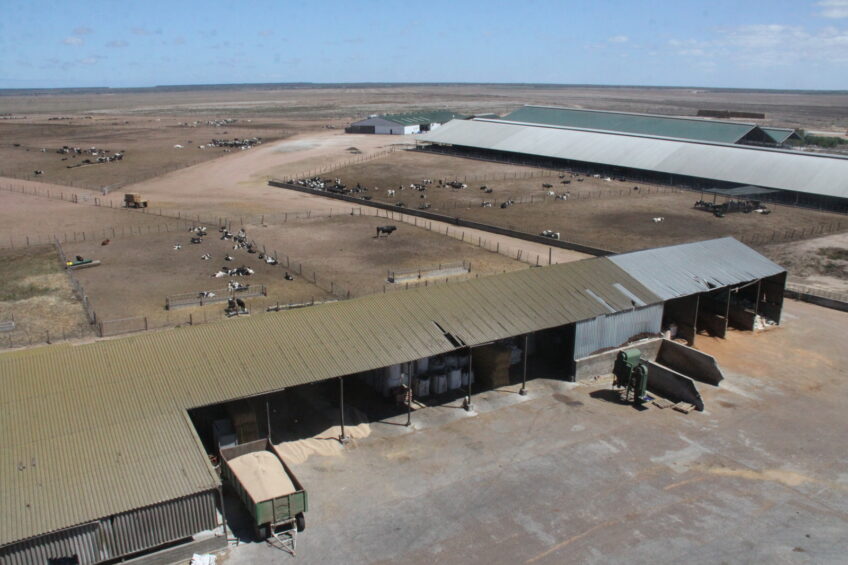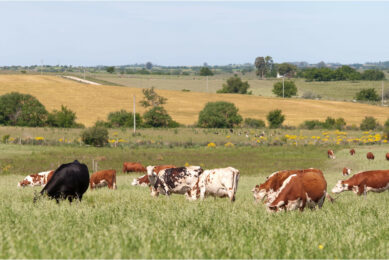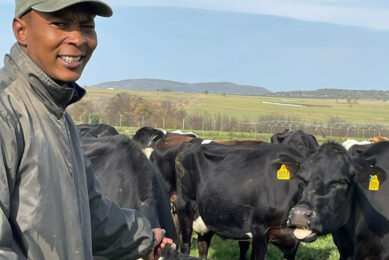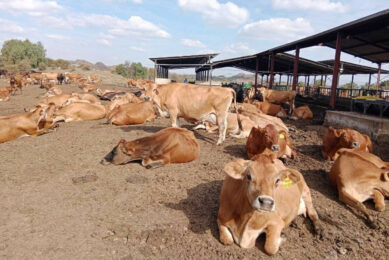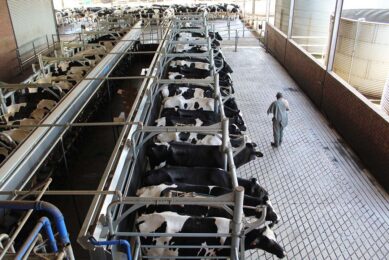After scaling down its wheat production and expanding its dairy herd over the last 15 years from 350 to 2 350 cows, a family farm in South Africa’s Western Cape province improved its average milk yield gradually by 42% to 14 600 kg/cow per year.
This farming enterprise now also invested R10 million in its own bio-digester. Biogas plants on SA farms were previously regarded as too expensive, but a SA engineering company came up with an effective design that is 42-55% cheaper than a European system.
North of Cape Town, near the town of Darling, the brothers Willem and Paul Basson run a mixed farming enterprise on the farm Uilenkraal (1 500ha). Because of a low average rainfall of just 300mm per year, wheat production contributes only 7% to their farming income, while 65% comes from milk production. Moreover, they produce potatoes under irrigation from boreholes, fodder crops such as oats, sweet lupines, canola and maize, while they also farm Dohne Merino sheep, Bonsmara beef cattle and ostriches. In the farm’s feed mill concentrates are manufactured for their own animals and for other farms. Two thirds of the dairy herd are housed in modern Italian cow barns and currently they have 1 200 cows in milk. They receive R4,54/litre, while their input costs are R3,70/litre.
The team that runs Uilenkraal are from left to right Willem Basson’s son Coenraad (23); Paul Basson (54); milk manager Dries Venter (46); and Willem Basson (60). After completion of his agricultural studies Coenraad recently worked for a year for North Florida Holsteins in the USA.
A historic photograph that hangs in the farm office shows what the farm yard looked like in 1953. Willem and Paul are the fourth generation of Bassons on Uilenkraal, while Coenraad represents the 5th generation.
A historic photograph that hangs in the farm office shows what the farm yard looked like in 1953. Willem and Paul are the fourth generation of Bassons on Uilenkraal, while Coenraad represents the 5th generation.
Uilenkraal’s Nutrikor feed mill is managed as a separate entity with its own book keeping. The feed mill takes up 60% of the farm’s electricity consumption, the dairy 20% and irrigation 20%.
Various raw materials are kept in storage for the Holstein cows’ total mixed rations. Uilenkraal produces dry land wheat on 750ha which ensures adequate amounts of roughage, but lucerne bales are bought in.
Uilenkraal’s feed mill dates back to 1990. It employs 29 full-time workers and produces 2 800t of feed per month of which half is used for the dairy herd.
Uilenkraal’s dairy employs 46 workers on a full-time basis. High quality compost is used for the cows’ bedding and workers remove faeces from the cubicles on a regular basis.
Within six hours after birth Uilenkraal’s calves get three 2 litre portions of colostrum. Yellow plastic tags are attached to the calf pens after each feeding of colostrum.
A mastitis test being conducted in the 60 point rotary milking parlour. Since Uilenkraal invested in Italian designed cow barns with automatic slurry scrapers, the occurrence of mastitis dropped drastically.
Every time a calf eats a 1kg portion of pellets per day, a red plastic tag is attached to its pen. When it does so for a second time, it will be weaned within three days.
Uilenkraal produces maize for silage under centre pivot irrigation on 40 hectares. The Bonsmara beef cattle in the foreground are kept from the maize fields with electric fencing that uses solar power.
Italian designed scrapers automatically remove cow dung / slurry three times per day from the cow barns; 200m³ of dung / slurry are being pumped into the bio-digester on a daily basis.
After slurry has moved through the bio-digester it is separated to turn the solids into high quality compost for bedding for the cows, while the fluids are pumped into an irrigation dam.
Lucerne bales are being deposited into the farm’s smaller mix wagon which features a horizontal augur and has a 16 cubic metres holding capacity.
The bigger mix wagon with a vertical augur and a holding capacity of 21 cubic metres loads oats silage from one of the farm’s bunkers. The farm produces dry land oats on 750 hectares.
A mix wagon off-loads a total mixed ration for the cows. With an aim to have 2 000 cows in milk within a year from now, the farm already invested R36,4m in new housing.
Construction of the farm’s new oats silage bunker was completed in 2013. The bunker is 5m high, 15m wide and 170m long which gives it a holding capacity of 11 000t.
Hanging 3m above the ground from the ceilings slow moving fans are switched on and off automatically to prevent heat stress in the cow barns. A canola field can be seen in the background.
Uilenkraal uses the Israeli system Afikim to keep meticulous electronic records in the computer room adjacent to the rotary milking parlour in order to ensure efficient management of its herd.
Uilenkraal’s milk is sold to Darling Creamery where it is processed in the nearest town about 20km from the farm. The milk is fetched by tankers twice per day.
Ceiling fans were also installed in the area from where cows enter and exit the rotary milking parlour in order to keep them cool.
Join 13,000+ subscribers
Subscribe to our newsletter to stay updated about all the need-to-know content in the dairy sector, two times a week.
"*" indicates required fields



